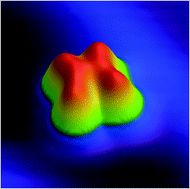The electronic and geometrical structure of single difluoro-bora-1,3,5,7-tetraphenyl-aza-dipyrromethene (aza-BODIPY) molecules adsorbed on the Au(111) surface is investigated by low temperature scanning tunneling microscopy and spectroscopy in conjunction with ab initiodensity functional theory simulations of the density of states and of the interaction with the substrate. Our DFT calculations indicate that the aza-BODIPY molecule forms a chemical bond with the Au(111) substrate, with distortion of the molecular geometry and significant charge transfer between the molecule and the substrate. Nevertheless, most likely due to the low corrugation of the Au(111) surface, diffusion of the molecule is observed for applied bias in excess of 1 V.

The electronic and geometrical structure of single difluoro-bora-1,3,5,7-tetraphenyl-aza-dipyrromethene (aza-BODIPY) molecules adsorbed on the Au(111) surface is investigated by low temperature scanning tunneling microscopy and spectroscopy in conjunction with ab initiodensity functional theory simulations of the density of states and of the interaction with the substrate. Our DFT calculations indicate that the aza-BODIPY molecule forms a chemical bond with the Au(111) substrate, with distortion of the molecular geometry and significant charge transfer between the molecule and the substrate. Nevertheless, most likely due to the low corrugation of the Au(111) surface, diffusion of the molecule is observed for applied bias in excess of 1 V.
